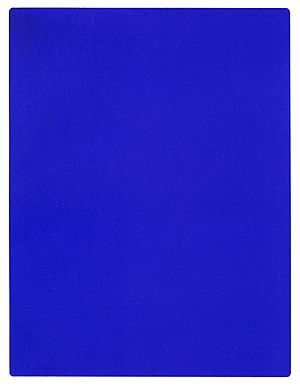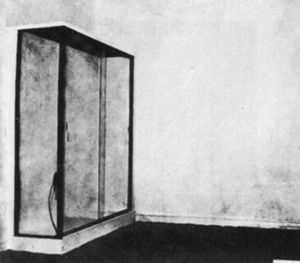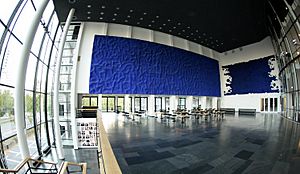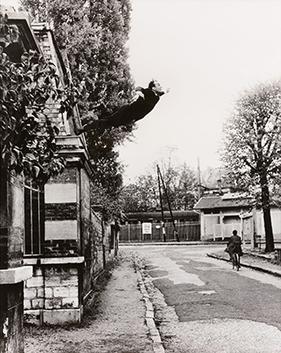Yves Klein facts for kids
Quick facts for kids
Yves Klein
|
|
|---|---|
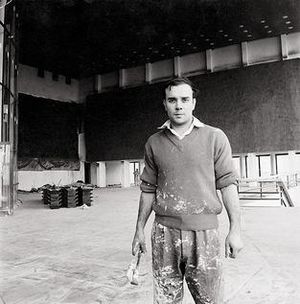
Yves Klein during the work on the Gelsenkirchen Opera, 1959
|
|
| Born | 28 April 1928 Nice, France
|
| Died | 6 June 1962 (aged 34) Paris, France
|
| Nationality | French |
| Known for | Painting, performance art |
|
Notable work
|
IKB 191 (1962) Monotone Symphony (1949) |
| Movement | Nouveau réalisme |
| Spouse(s) | Rotraut Klein-Moquay |
Yves Klein (born April 28, 1928 – died June 6, 1962) was a famous French artist. He was a very important person in European art after World War II. Klein was a main member of a French art group called Nouveau réalisme, which started in 1960. He was also one of the first artists to create performance art. Many people see him as an inspiration for later art styles like minimal art and pop art.
Contents
About Yves Klein
Yves Klein was born in Nice, France. His parents, Fred Klein and Marie Raymond, were both painters. His father painted in a style that looked like real things, but his mother was a leader in Art informel, which is a type of abstract art. She often held gatherings with other abstract artists in Paris. Yves Klein did not go to art school, but his parents taught him about many different art styles.
From 1942 to 1946, Klein studied at special schools for the navy and for learning foreign languages. During this time, he became friends with Arman and Claude Pascal. This is when he started to paint. In 1948, Klein learned about a spiritual group called Rosicrucianism and became interested in it.
Judo Master
While studying, Klein also began practicing judo. Between 1948 and 1952, he traveled to Italy, Great Britain, Spain, and Japan. In 1953, when he was 25, he became a judo master in Japan. He earned the rank of yodan (a 4th degree black-belt) from the Kodokan Judo Institute. He was the first European to reach this high rank. Later that year, he became the coach for the Spanish judo team. In 1954, Klein wrote a book about judo called Les Fondements du judo. The same year, he moved back to Paris for good and began his art career seriously.
Music and Silence
Between 1947 and 1948, Klein came up with his Monotone Symphony. This piece of music was very unusual. It had a single, long sound that lasted for 20 minutes, followed by 20 minutes of complete silence. This idea was a hint at his later art, which often used only one color. It also influenced minimal music artists like La Monte Young and John Cage.
His Artworks
The Blue Period
Yves Klein had been painting artworks with only one color since 1949. His first public display of these works was a book called Yves Peintures in 1954. This book showed many intense single-color paintings. His first two art shows in Paris in 1955 and 1956 featured orange, yellow, red, pink, and blue single-color paintings. Klein was disappointed because people saw them as just different parts of a mosaic, not as complete artworks on their own.
His next show in Milan in 1957 was called 'Proposition Monochrome; Blue Epoch'. It showed 11 blue canvases that all looked the same. He used a special blue color made from ultramarine pigment mixed with a clear resin. This made the blue color look very bright and deep. Klein worked with a paint dealer to create this special mix. This color later became known as International Klein Blue (IKB). The paintings were hung away from the walls to make them seem to float. Each of the 11 blue canvases had a different price. Klein wanted buyers to choose the one that felt most special to them, even though they looked identical. He believed each person would see something unique in the canvas they chose.
This show was very successful and traveled to other cities. For the opening of his Paris exhibition in 1957, Klein released 1001 blue balloons. He even used IKB stamps on postcards, which he convinced the postal service to accept!
The Void
For his next exhibition in 1958, Klein decided to show nothing at all. He called it The Specialization of Sensibility in the Raw Material State into Stabilized Pictorial Sensibility, The Void. He emptied the art gallery, painted everything white, and then created a special entrance for the opening night. The gallery window was painted blue, and a blue curtain hung at the entrance. There were even guards and blue cocktails! Because of a huge advertising effort, 3,000 people waited in line to enter an empty room.
Klein had studied judo and was interested in Zen Buddhism. He used these ideas to explore how art could be about more than just physical objects. He wanted people to experience a feeling of "nothingness" or "the void," which he saw as a pure, empty space where new ideas could form.
Later, Klein was asked to decorate the Gelsenkirchen Opera House in Germany. He created huge blue murals, some as large as 20 meters by 7 meters. To celebrate this, he went to Italy and left a special offering at a monastery. It was a small clear box with three parts: one with IKB blue pigment, one with pink pigment, and one with gold leaf. He prayed that all his art would be beautiful.
Klein also created works using sponges that he had used to paint his blue canvases. He mounted these sponges on metal rods and placed them in rocks.
Living Brushes
Even though his IKB paintings were all one color, Klein tried different ways to apply the paint. He used rollers and sponges, which created different textures. This led him to create works using models covered in blue paint. He would have them roll or lie on canvases to make an image. He called this type of work Anthropometry, which means "human measurement." He called the models "living brushes."
Sometimes, creating these paintings became a type of performance art. For example, in 1960, an audience dressed in fancy clothes watched models create these paintings while musicians played Klein's Monotone Symphony.
In another performance called Zones of Immaterial Pictorial Sensibility (1959–1962), Klein offered to sell empty spaces in the city. He wanted buyers to experience "The Void" by buying nothing. He believed this experience could only be paid for with the purest material: gold. In return, he gave the buyer a certificate of ownership. In a second part of the performance, if the buyer burned the certificate, Klein would throw half the gold into the river. He said this was to bring back the "natural order" that he had changed by selling the empty space. He used the other half of the gold to create artworks covered in gold leaf.
The Famous Jump
Klein is also famous for a special photograph called Saut dans le vide (Leap into the Void). It was published in his 1960 art book. The photo seems to show him jumping off a wall with his arms out, heading towards the ground. Klein used this photo to suggest he could travel to the moon without help. However, this photo was actually a photomontage. His friends held a large tarp for him to jump onto, and the tarp was removed from the final picture.
Klein's art was often about a Zen-inspired idea he called "le Vide" (the Void). For Klein, the Void was a peaceful state, free from everyday worries. It was a neutral place where you could focus on your own feelings and on "reality" itself, not just pictures of reality. He made art forms like paintings, books, and music, but then took away the usual content. For example, paintings without pictures, books without words, and music without a complex tune. He wanted to create a feeling of "Zones of Immaterial Pictorial Sensibility" for his audience.
Instead of drawing objects in a personal way, Klein wanted to show them by their "imprint," or the image of their absence. He wanted his audience to both "feel" and "understand" an idea at the same time.
Other Works
Besides flat paintings, Klein also made works that mixed painting and sculpture. He painted plaster copies of famous sculptures, like the Winged Victory of Samothrace, in International Klein Blue. He also painted a globe and 3D maps of France. He even stuck sponges to canvases and painted dinner plates. Many of these works were later made into multiple copies after he passed away.
In a project called Blue Obelisk, which he planned in 1958 but was completed in 1983, he lit up the central obelisk in the Place de la Concorde in Paris with blue spotlights.
Later Life and Death
The art critic Pierre Restany helped Klein start the Nouveau Réalisme art group in 1960. This group included artists like Arman and Jean Tinguely. Nouveau Réalisme is often seen as a French version of Pop Art. Their goal was to find "new ways of seeing what is real."
Klein had a big art show in Germany in 1961. He then had a show in New York, but he didn't sell any paintings there. While in New York, he wrote the "Chelsea Hotel Manifesto," which talked about many new possibilities in art.
He also showed his art in Los Angeles and traveled in the western United States, visiting places like Death Valley. In 1962, Klein married Rotraut Klein-Moquay. Their son was born shortly after his death.
Yves Klein had a heart attack while watching a film at the Cannes Film Festival on May 11, 1962. He had two more heart attacks and passed away on June 6, 1962.
His Legacy
Many people see Yves Klein as an early postmodern artist. His ideas and art continue to influence others.
A funny scene that makes fun of Klein's Anthropometry performance is in the 1961 film Wise Guys.
The Yves Klein archive, which holds many of his works and papers, is kept in Phoenix, Arizona, where his wife Rotraut Klein-Moquay lives.
In 2017, a Welsh rock band called Manic Street Preachers released a song named "International Blue." The song was inspired by Yves Klein and his famous blue color. The band's bassist, Nicky Wire, said the song was about the joy of loving something like Yves Klein's art.
Podcasts like A Piece of Work (from MoMA and WNYC) and This is Love have also featured episodes about Klein and his blue artworks. In 2021, a short novel called Blue Postcards by Douglas Bruton was written about Yves Klein's life and art.
Art Market
Yves Klein's paintings have sold for very high prices at art auctions. For example, his blue sponge painting RE 46 sold for $4.72 million in 2006. In 2008, a gold painting called MG 9 sold for $21 million. In 2012, his large artwork FC1 (Fire Color 1), made with a blowtorch and water, sold for $36.4 million. In 2013, a sculpture made with natural sea sponges dipped in blue pigment, Sculpture Éponge Bleue Sans Titre, SE 168, sold for $22 million.
See also
 In Spanish: Yves Klein para niños
In Spanish: Yves Klein para niños


